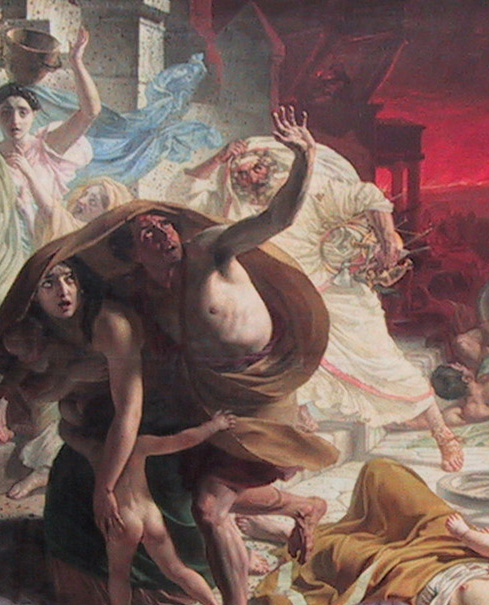 1>
1>Luxury and decadence
Throughout The Last Days of Pompeii, Bulwer-Lytton narrates highly contrived descriptions of houses and their interiors, which are specifically designed to heighten the narrative’s dramatic content. His descriptions, like those contained in the Satyricon, also went on to play a large part in shaping popular perceptions of Roman society. Luxurious beauty spilling over into decadent opulence are themes common to both authors. In the case of Lytton these are fully realised in the various descriptions of Arbaces’s house. The evil priest of Isis is housed in a Palace that is full of sumptuous furnishings and ‘pictures of inestimable value’, all of which Arbaces uses to seduce the novel’s heroine - Ione (p.150). It is very likely that Lytton appropriated the iconic cliché of the corrupt gold loving Pagan priest form Karl Briullov’s megalographic painting the Last days of Pompeii, which he saw in1833 whilst en route to Rome and Naples. The pagan priest is depicted trying to escape with religious objects made of gold, as Vesuvius rains down molten lava on Pompeii (fig.1). In the novel Arbaces’s attempt to seduce the pure Ione fails and in so doing it reinforces Lytton’s view that luxury can only be acquired and appreciated by aristocratic gentlemen (such as himself). Whereas... “the house of Glaucus was at once one of the smallest, and yet one of the most adorned and finished of all the private mansions of Pompeii: it would be a model at this day for the house of 'a single man in Mayfair' – …”
[ http://archive.org/details/lastdaysofpompeii00lyttiala > p22 ]
Unfortunately, subtle ironies such as these never surface in popular readings or visualisations of the book. On the contrary, its numerous film versions came to epitomise the belief that Pompeian society was brought down by the hedonistic acquisition of luxury accompanied by immoral behaviour. The fact that Arbaces was probably not Italo-Roman, but a priest linked to the Egyptian royal court seems to have mattered little.
The hedonistic pursuit of new luxuries, which was held responsible for the collapse of Roman social and moral values, is sometimes juxtaposed with a bygone halcyon age, often referred to as the Golden Age, usually characterised by an idyllic combination of piety and glory. Horace once again provides the quintessential example.
Quaint garden-screens, too, woven of laurel-boughs
To parry sunstroke. Romulus never urged
This style of life; rough-bearded Cato
Would have detested the modern fashions.
Small private wealth, large communal property –
So ran the rule then. No one had porticoes
Laid out with ten-foot builder’s measures,
Trapping the cool of the north shadow.
No one in those days sneered at the turf by the
Roadside; yet laws bade citizens beautify
Townships at all men’s cost and quarry
Glorious marble to roof the temples.
Horace Odes II.15.9-20. (Penguin 1970 - ed. James Michie)
1 Karl Briullov, Last Days of Pompeii, 1833, detail showing a Pagan priest escaping with gold and silver objects, whilst in the near ground a selfless act of devotion is being carried out by a young mother and father who are attempting to protect their children from the lava that is raining down on them.
|